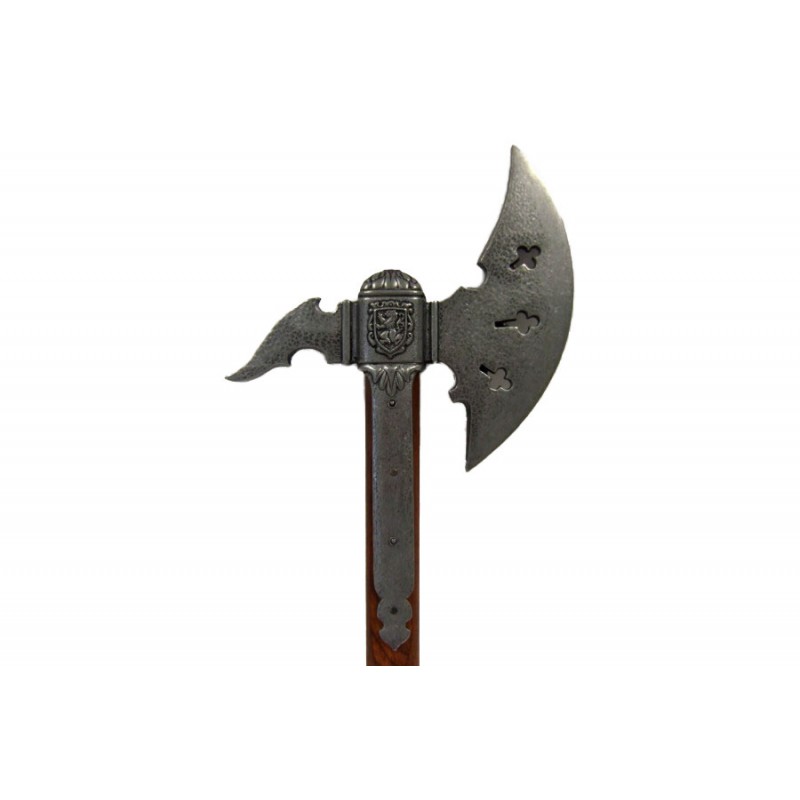

This was the common form of the European single-hand battle-ax thereafter. Although there were variations, the broadax continued to be developed from a basic one- or two-pound weapon with a haft of about 1½ feet of ash or oak. This was probably the earliest broadax form and enabled a more effective sweeping cut rather than a simple chop.
#GERMAN BATTLE AXE FULL#
The Norse Battle-AxĪnother Norse style of the ninth century returned to the full arc of convex edge, tapering both the top and undersides of the head backward in a concave sweep to the haft, sometimes known as the shaved ax. Scandinavian smiths had been working iron-edged weapons, and they usually made the ax head of iron and forged the edge into steel to make it a superior cutting face. Called the bearded ax, the weapon would undergo changes such as sweeping into an arc at the heel of the edge. The Vikings extended the francisca ax edge downward a further inch, with the underside at the heel cutting briefly back horizontally and then turning up into a deep concave arc. The francisca, after undergoing changes of the length of edge, became popular with other Germanic peoples such as the Anglo-Saxons, and made its way farther north to become a basic template for the expeditionary Vikings. The Franks capitalized on this by throwing the francisca in volleys to confuse, intimidate, and disorganize the enemy lines before or during a charge to initiate close combat. It could rebound at opponents’ legs or against their shields and through the ranks. Even if the edge of the blade did not strike the target, the weight of the iron head could cause serious injury.Īnother feature of the francisca was its tendency to bounce unpredictably upon hitting the ground due to its weight, unique shape of the head, lack of balance, and slight curvature of the haft, making it difficult for defenders to block.

The weight of the head and short length of the haft allowed the ax to be thrown with considerable momentum to an effective range of about 40 feet. And they are accustomed always to throw these axes at one signal in the first charge and thus shatter the shields of the enemy and kill the men.” Procopius stressed that the Franks threw their axes immediately before hand-to-hand combat, for the purpose of breaking shields and disrupting the enemy line while wounding or killing enemy warriors. Now the iron head of this weapon was thick and exceedingly sharp on both sides while the wooden handle was very short. The Roman historian Procopius described its use as a throwing weapon by the Franks: “Each man carried a sword and shield and an ax. The francisca was used both as a throwing and close-combat weapon. The Franks made up the western German confederation that would evolve into a multipart kingdom under the Merovingian rulers and then an empire under the Carolingian rulers of the seventh and eighth centuries, particularly Charlemagne. This ax was called the francisca (from the Latin word for Frank). By the fifth century, a battle-ax with a narrow, wedge-shaped head, usually a flat arch or S-shaped top side with a rather flat, beveled convex edge of approximately three inches turned back at the heel in a concave sweep at the underside, appeared in northern Europe in the hands of the Franks. Roman legionaries carried a standard pickax with a short edge on a 19-inch head and a 30-inch haft. Unlike its farm implement predecessor, the battle-ax was meant to cut flesh, not wood. The single-beveled edge head was soon developed. Axes with double front and rear edges cropped up in some ancient cultures but, realistically speaking, were too heavy for real efficiency.

For warfare, the battle-ax was most efficient in a light design. By the Iron Age (1000 bc), the wedge-shaped iron ax head was the standard form, drilled near the butt for hafting. From rather blunt faces in rectangular shapes, the ax head took on the familiar, slightly convex front edge and tapered back to the blunted butt. With the discovery of metals came the various work of accommodating axes for warfare. Many stony minerals were used for the head, and the edge was sharpened on both sides and double beveled. Socketing required the haft to be drilled with a hole to fit a shaped stone through the haft or on top of it. Techniques of handle attachment included wedging, flanging, winging, and socketing. The first ax heads were made of stone and used by hand a wood handle known as the haft made ax wielding easier. The so-called battle-ax cultures (3200 to 1800 bc) extended over much of northern Europe from the late Stone Age through the early Bronze Age. The shafted ax has been around since 6000 bc, in both peaceful and warlike uses.


 0 kommentar(er)
0 kommentar(er)
